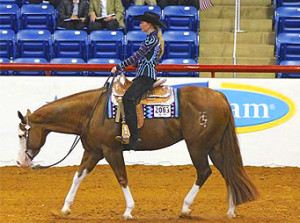Thinking On Your Feet – Implementing Show Ring Strategy
Click here to read the complete article196 – November/December, 2017
BY DELORES KUHLWEIN
 When you’re showing, how much does ring strategy really matter? Devising a plan counts, say the experts, and practices like utilizing corners for rail position, looking ahead to obstacles, timing your reverse on the rail, and thinking on your feet (or in your stirrups) can pay off in the show pen.
When you’re showing, how much does ring strategy really matter? Devising a plan counts, say the experts, and practices like utilizing corners for rail position, looking ahead to obstacles, timing your reverse on the rail, and thinking on your feet (or in your stirrups) can pay off in the show pen.
Read on for some of the best approaches for show ring strategy with a focus on Western Pleasure, Trail, and Western Riding.
Western Pleasure Practices
Although it might not be apparent to a spectator sitting the stands, strategy reigns supreme in the average Western Pleasure class, and creating a plan begins even before the class.
“I go look at the arena when I arrive and analyze it,” reveals Troy Compton of Purcell, Oklahoma, the producer of thousands of world class show horses. “You have to do the Trail walk-through, and you have to do the same for Western Pleasure. The first element you consider is the size of the arena – is it an arena that will allow for a freer moving horse, or are we going to have to tighten it up a bit?”
Viewing the arena and the length of each rail also helps Compton determine how deep corners are, another factor for making a plan in the pen. The benefits of using corners effectively are numerous according to multiple World Champion trainer Kenny Lakins of Wilmington, Ohio. He explains that not only should you ride them deep, you should practice until your cornering skills are perfect. The goal is to use as much of that extra space as possible, not to bank off the wall like you’re driving a racecar. “The corners are a great place to have your horse pick up their shoulders and sit back on their hocks,” he explains. “This will also help you set up for a great start down the rail.”
Compton says arena corners can also be used to accomplish good spacing and to achieve a better rail spot. “If I need to pass, I’m going to use my corners to make my path and cut across that pen a bit more. It enables me to give the person I’m passing more room.
“In Western Pleasure, there’s a perfect, sweet spot balance of body position, and I want to get the horse at just a bit of an angle with the outside eye hooked up to the rail, looking straight down the rail, and I want to use that rail to push them up a bit to utilize their shoulders.” The idea of staying close to the rail has a purpose as well, Compton continues. He says, “The reason we want to stay close to the rail is because if we cut to the inside, we shorten the arena.”
Click here to read the complete article196 – November/December, 2017










